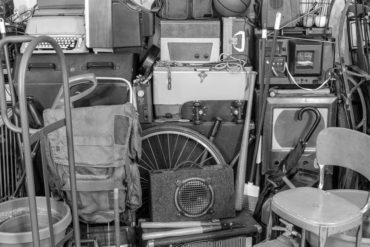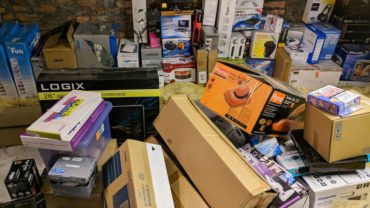 A china cabinet full of crystal goblets and a lovely set of gold-rimmed china. A room full of bookshelves, chock full of first editions and illustrated volumes. A glass case containing cloisonné snuff boxes from around the world. All clearly collections, lovingly accumulated over time and having intrinsic value to the owner, right?
A china cabinet full of crystal goblets and a lovely set of gold-rimmed china. A room full of bookshelves, chock full of first editions and illustrated volumes. A glass case containing cloisonné snuff boxes from around the world. All clearly collections, lovingly accumulated over time and having intrinsic value to the owner, right?
A room full of dolls, strewn about in a haphazard fashion, some in glass cases, some in a heap, gathering dust. Boxes full of books, clearly unopened for some time. A china cabinet filled with a mishmash of items, some great, some junk, all dusty and unorganized. We certainly have a hoarding situation here.
Both of these cases seem very cut and dried to the casual observer. Of course, our assumptions are correct based on what the evidence is. What we aren’t seeing is that in the first scenario, the rooms that are out of view are packed to the rafters. Items in bags, with tags still attached, are everywhere. The door barely opens. There is no way to know the contents of the room because the floor and walls are completely covered.
 In the second, what we see is the entire picture. Cluttered and perhaps a little dirtier and dustier than is our personal preference, but no secrets anywhere. The homeowner is a bookseller, in the process of listing items from a recent sale. The dolls were inherited from a deceased relative, and their disposition is undecided. The china closet is a keepsake that was not particularly wanted, but was left in a will to the recipient. It’s not even on the radar.
In the second, what we see is the entire picture. Cluttered and perhaps a little dirtier and dustier than is our personal preference, but no secrets anywhere. The homeowner is a bookseller, in the process of listing items from a recent sale. The dolls were inherited from a deceased relative, and their disposition is undecided. The china closet is a keepsake that was not particularly wanted, but was left in a will to the recipient. It’s not even on the radar.
The point: Perception can be very, very wrong. Collecting and hoarding look similar. There is no way to tell what kind of situation it is, unless the full picture is available. Hoarding behaviors are sneaky. Many people who suffer with hoarding disorder are quite adept at hiding it, even from their closest friends and family.
So very often, as human beings, we rush to judgement. “Oh, he/she is a hoarder!” is the refrain when we observe a living situation that is out of our comfort level. Too much stuff, clutter, mess. My home only has service for four — why on earth would a two-person household need china service for 20?
Unknown to most people is that nearly everyone is a hoarder. Yes, you read that correctly. Everyone is a hoarder.
 Most of you are probably thinking, “Is this writer off her rocker? How dare she say I’m a hoarder!” Hello, my name is Margaret. I’m a professional organizer, and I am a level-one hoarder.
Most of you are probably thinking, “Is this writer off her rocker? How dare she say I’m a hoarder!” Hello, my name is Margaret. I’m a professional organizer, and I am a level-one hoarder.
Why do I say this? Professional organizers use a five-level scale to define and assess each situation. Most of us are level one. Loosely defined, it means no excessive clutter (think a bit of mail on the table or a few items the kids have strewn about), all doors and staircases are accessible, there are no funky smells, and the home is safe and sanitary. This is the way most of us live. At this point, hopefully all is forgiven and we can move on.
Hoarding is defined as a mental health disorder in which people struggle to get rid of possessions that are no longer useful, and efforts to get rid of those items and to not obtain more items cause them distress. Levels two through five are when this comes into play.
Level two is the most common type of hoarding. Two or more rooms are cluttered. There may be some slight odors, heaped trash cans, a little mildew in the bath or kitchen, perhaps a blocked exit, evidence of pet waste or dander and limited evidence of housekeeping.
Level three is a bit more serious. One bedroom or bathroom is unusable. Kitchen is very dirty. There’s excessive dust, strong odors and excessive amounts of pets, and usually the clutter is beginning to migrate outside.
Level four is when intervention of some type needs to be brought in. Plumbing that may no longer work; hazardous wiring; flea, lice or arachnid infestations; rotting food on counters; and pet damage to the home are all signs. Mental health professionals as well as hoarding remediation and possible biohazard remediation need to be considered in this very serious situation.
Level five is an emergency, to be sure. Rodent infestation; unusable kitchen and bathroom facilities; human and animal feces; and disconnected water, sewer and electrical service are all items of concern. Adult services as well as code enforcement are points of contact when intervention by family and friends is not successful.
 Caution should be exercised in our zeal for others to conform to our way of living. Someone with a room full of Barbie dolls or a two-bay garage with train sets may be a collector of those items. They may also be a hoarder. Unless and until the situation can be fully and completely assessed, this cannot be a fair judgement made.
Caution should be exercised in our zeal for others to conform to our way of living. Someone with a room full of Barbie dolls or a two-bay garage with train sets may be a collector of those items. They may also be a hoarder. Unless and until the situation can be fully and completely assessed, this cannot be a fair judgement made.
The collector, over time, can begin to exhibit hoarding behavior. A person who perhaps loved collecting high-end cookware may begin to accumulate unreasonable amounts of it. There may be two sets in the kitchen and five more hiding in the garage, with plans to obtain more as they go on sale or are found at tag sales. Being mindful of changes in people in our personal circles is one of the best ways to help those with hoarding tendencies.
Most often, hoarding behaviors are brought on by trauma. Divorce, loss of a loved one, a health crisis — any of them can be a trigger and there is no magic mirror we can look into that will predict who may be affected. The best tool we have is to be involved.





























